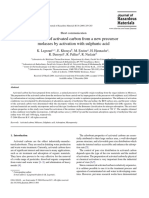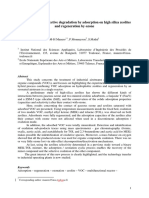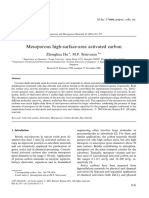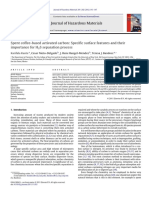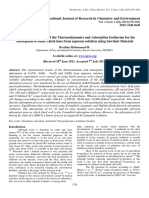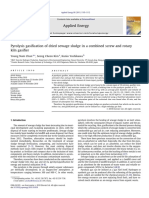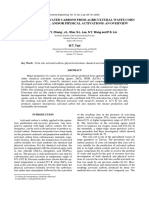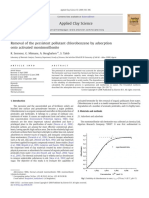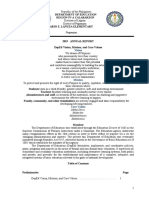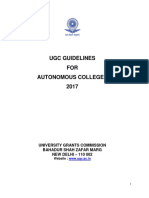KoreanJ.Chem.Eng
.,
23
(5),773-778(2006)
SHORTCOMMUNICATION
773
†
Towhomcorrespondenceshouldbeaddressed. E-mail:shlee@pknu.ac.kr
Comparisonofvaporadsorptioncharacteristicsofacetoneandtoluenebasedon polarityinactivatedcarbonfixed-bedreactor
Min-GyuLee,Song-WooLeeandSeok-HeeLee
†
DivisionofAppliedChemicalEngineering,PukyongNationalUniversity,Busan608-739,Korea (
Received24February2006•accepted4May2006
)
Abstract
−
Adsorptioncharacteristicsaccordingtopolarityofacetoneandtoluenevaporsoncoconutbasedactivated carbonwereinvestigatedbyusingafixedbedreactor.Singlevaporandbinaryvaporadsorptionofacetoneandtoluene wereconducted.Inthesinglevaporsystem,theequilibriumadsorptioncapacityoftoluenevaporonactivatedcarbon wasfivetimeshigherthanthatofacetonevaporbecauseofpolaritydifferencebetweenadsorbentandadsorbate.The breakthroughcurveofacetonevaporinthebinaryvaporwasquitedifferentfromthatofsingleacetonevapor.Acetone adsorbedinthebinaryvaporwassubstitutedwithtolueneduetotheaffinitydifferenceduringadsorptionprocessand itsoutletconcentrationincreasedto1.6timesthaninletconcentration.Thetemperaturechangesinactivatedcarbon bedduringadsorptionofacetonevaporandtoluenevaporoccurredinthetimerangesof10-30min.Thetemperature changeforacetonevaporadsorptionwasabout3
o
C;however,thatfortoluenevaporadsorptionwasincreasedto33
o
C maximally. Keywords:ActivatedCarbon,Adsorption,AcetoneVapor,TolueneVapor,BreakthroughCurve
INTRODUCTION
Enormousquantitiesofvariousorganicsolventshavebeenan- nuallyproducedfromavarietyofindustrialsources.Theemission oftheseorganicsolventsintheatmospherehascausedharmfulef- fectsonhumanhealthandontheenvironment.Sincetheyaredi- rectlyrelatedtobothhumanhealthandenvironment,thereismuch publicconcernaboutwidespreadenvironmentalpollution.Thevol- atileorganiccompounds(VOCs)amongorganicsolventsarecriti- caltoxicsubstances.Thesesubstancesmayhaveharmfuleffects onhumanhealthandcouldevencausecancerifpeopleareexposed foralongtime. Manymethodstotreattheseorganicsolventshavebeendevel- oped.Theyareclassifiedintwobroadgroups:oxidationmethod andrecoverymethod.Oxidationmethodissimplytodestructthe organicsolventsintoharmlessmaterialssuchasCO
2
andH
2
O,but itisimpossibletoreusetheVOC,andthismethodisexpensiveand energyexhausting.Inthiscontext,therecoverymethodisableto reusetheusedorganicsolventsandhasmanyadvantagesinclud- ingorganicsolventrecovery,energysavings,andenvironmentally safeaspect.Therecoverymethodstorecovertheusedorganic solventsintheairarecondensation,adsorptionbyadsorbents,ab- sorptionbyabsorbingagents,ion-exchange,andmembranefiltration [Kangetal.,2000].
Amongthesemethods,theadsorptionmeth- odisconsideredasthemostpromisingtechnologyinviewpointof organicsolventrecoveryandenergysavings.Also,theadsorption methodisregardedaseffectivetechnologybecauseitispossibleto separateadsorbateselectivelyaccordingtoporestructureofadsor- bent.Inadsorption,theadsorptionefficiencyisgovernedbychar- acteristicsofadsorbateandadsorbent.Therefore,itisveryimportant tochoosetheappropriateadsorbent. Activatedcarbonisoneofthemosteffectiveadsorbentmateri- alsandiswidelyusedinadsorptionprocess.Thelargesurfacearea, welldevelopedmicroporousstructure,andrapidadsorptioncapa- bilityofactivatedcarbonprovideveryeffectiveperformancesfor removingpollutantsfromtheeffluentairstream.Manyresearchers havestudiedtheeliminationandtherecoveryofVOCsusingvar- iousactivatedcarbons[Hwangetal.,1998;Leeetal.,1999;Kim etal.,2002].Popescuetal.[2002]studiedthebehaviorofadsorp- tionanddesorptionoftoluene,butylacetate,andbutanolonacti- vatedcarbons,andChiangetal.[2001]publishedtheexperimental resultsoftolueneaccordingtoporestructureofactivatedcarbon andadsorptiontemperature.Harikrishnanetal.[1998]investigated adsorptioncharacteristicsofethylbenzeneaccordingtopressure andtemperature,andKangetal.[2000]publishedtheexperimen- talresultsusingactivatedcarboninthebenzenerecoveryprocess. Kimetal.[2001b]studiedtheadsorptioncharacteristicsofbenzene inanactivatedcarbonfixedbedreactor,andKimetal.[2001a]stud- iedtheadsorptionofthreemajorsolventvaporssuchasn-hexane, toluene,andMEKontwopelletizedcommercialactivatedcar- bons.Yunetal.[1997]studiedthedynamicbehaviorofnon-ideal gasmixturesinanisothermalfixed-bedadsorber.Butthesestudies weremainlyconcernedwithadsorptionofnonpolarorganiccom- pounds,andtheywerehardlyconcernedwithadsorptionofpolar organiccompounds.AlthoughHuangetal.[2003]andLeeetal. [2004]studiedforacetoneandpolarorganiccompounds,theymerely estimatedtheequilibriumadsorptioncapacityandadsorptionabil- ityaccordingtotemperature.ButVOCsgeneratedfromplantsand factoriesarecomposedofpolarandnonpolarorganiccompounds mixedwitheachother.Soadsorptioncharacteristicsbetweenpolar andnonpolarorganiccompoundswerethoughttobedifferent. Thepresentworkfocusesontheinvestigationoftheadsorption characteristicsaccordingtopolarityofadsorbate.Thebreakthrough experimentswereconductedasafunctionofinletconcentration andlinearvelocityofadsorbates,acetoneandtolueneusingacti-


774M.-G.Leeetal.
September,2006
vatedcarbonfixedbedreactor.Thetemperaturechangesbyheat ofadsorptioninactivatedcarbonbedwereinvestigated.Competi- tiveadsorptioninthemixedvaporofacetoneandtoluenewasalso investigated.
EXPERIMENTAL
Coconutbasedactivatedcarbonwaspreparedintheparticlesize of8-12mesh,andwasusedasadsorbentasinthepreviouspaper [Limetal.,2005].Characteristicsoftheactivatedcarbonarelisted inTable1.BETspecificsurfaceareawas1,145m
2
/g,totalporevol- umewas0.41cm
3
/g,averageporediameterwas19Å,andIodine numberwas1,100mg/g.Tolueneandacetoneof99.9
%
grade,ob- tainedfromSamchunChemicalCo.,Ltd.,Koreawereusedasad- sorbatewithoutpurificationinthisexperiment.Adsorptionexperi- mentswereconductedbyusingtheapparatusshowninFig.1.The experimentalapparatusconsistedofvaporgenerationpartandfixed bedforadsorption. Adsorptionexperimentswereconductedat20
o
C,andthefixed bedpreparedbyPyrextubeof16mminsidediameterwasused. Airfromanairpump(YoungNamYasunagaCo.Ltd.,LP-40A) wasfirstfedtothebottlepackedwithsilica-gelinordertomini- mizetheeffectofmoistureduringadsorption.Acetonevaporand toluenevaporwerepreparedbyvaporizingacetoneandtolueneflow- edoutfromsyringepump(ColeParmerInternational,U.S.A.,p- 74901-10).Vaporizedacetoneandtolueneweremixedthoroughly withdriedairpassingthroughthemixingchambertosetupacertain concentration,andthosevaporsflowedintothebottomsideofthe reactorandflowedoutfromtheupside.Theupsideofthereactor wasconnectedtotheinjectionportofthegaschromatograph(GC, DonamDS-6200).TheanalysisconditionsofGCareasinTable2.
RESULTSANDDISCUSSION 1.EffectofInletConcentrationofAdsorbateonBreakthrough Curve
Toinvestigatebreakthroughcharacteristicsaccordingtoinletcon- centrationofacetoneandtoluenevapors,anadsorptionexperiment
Table1.Characteristicsofactivatedcarbon
PropertiesValue Materialcoconut Particlesize(mesh)8-12 Iodinenumber(mg/g)1,100 BETspecificsurfacearea(m
2
/g)1,145 Totalporevolume(cm
3
/g)0.41 Averageporediameter(Å)19.0
Fig.1.Schematicdiagramofexperimentalapparatus.
①
Airpump
⑥
Adsorptionbed
②
Dryingbottle
⑦
Jacket
③
Flowmeter
⑧
GC
④
Syringepump
⑨
Vent
⑤
Mixingchamber
Table2.Analysisconditionsforacetonevaporandtoluenevapor bygaschromatography
GCDONAMDS6200 DetectorFID(FlameIonizationDetector) Oventemperature130
o
C Injectortemperature250
o
C Detectortemperature200
o
C Flowrate(N
2
:H
2
:Air,ml/min)30:30:300
Fig.2.Effectofinletconcentrationofacetonevaporonbreak- throughcurve(linearvelocity:0.42m/s,activatedcarbon: 2g). Fig.3.Effectofinletconcentrationoftoluenevaporonbreak- throughcurve(linearvelocity:0.42m/s,activatedcarbon: 2g).
Adsorptioncharacteristicsaccordingtopolarity775
KoreanJ.Chem.Eng.(Vol.23,No.5)
wascarriedoutat20
o
Cinthefollowingconditions:linearvelocity 0.42m/s,inletconcentrationofadsorbate60,90,120ppmv.The breakthroughcurvesofacetonevaporaccordingtoinletconcentra- tionarecomparedinFig.2.Andthebreakthroughcurvesoftoluene vaporaccordingtoinletconcentrationarecomparedinFig.3.As showninFig.2andFig.3,thehigherinletconcentrationofadsor- batewas,thefasterbreakthroughwas,andtheslopeofbreakthrough curvewasgraduallyincreased.Also,thevariationrangeofbreak- throughcurveofacetonevaporwasnotlargerthanthatoftoluene vapor.InFigs.2and3,breakthroughtime(t
B
)isdefinedastime whenoutletconcentrationwas10
%
ofinletconcentration,andwhen outletconcentrationwas50
%
ofinletconcentration,itwasdefined asstoichiometricbreakthroughtime(t
*
).Thebreakthroughtime, stoichiometricbreakthroughtime,andadsorptioncapacity(q)ac- cordingtoinletconcentrationobtainedfromFig.2and3werelisted inTable3.Asinletconcentrationofacetonevaporwasincreased from60ppmvto120ppmv,thebreakthroughtimewasdecreased from70minto30min.Andasinletconcentrationoftoluenevapor wasincreasedfrom60ppmvto120ppmv,thebreakthroughtime wasdecreasedfrom330minto170min.Wheninletconcentration was60ppmv,theequilibriumadsorptioncapacitiesofacetonevapor andtoluenevaporwere54mg/gand294mg/g,respectively.And wheninletconcentrationwasincreasedto120ppmv,thatistwice concentration,theequilibriumadsorptioncapacitiesofacetonevapor andtoluenevaporwere74mg/gand349mg/g,respectively.There- fore,asinletconcentrationsofacetonevaporandtoluenevaporwere increased,thebreakthroughtimewasdecreased,buttheequilib- riumadsorptioncapacitiesofacetonevaporandtoluenevaporwere increased.Atthesameconcentration,theequilibriumadsorption capacityoftoluenevaporwas4.7-5.4timesthanthatofacetone vapor.Thisresultisexplainedbythefactthatallowableadsorbate moleculesareincreasedasincreasingadsorbateconcentration;also, theadsorptionisfastasmuchastheincreaseofdiffusionvelocity andadsorptionvelocityintoporesofactivatedcarbon,sotimeto reachequilibriumisreduced.Also,itwasthoughtthattheincrease ofadsorptioncapacityaccordingtoincreasingadsorbateconcen- trationwasduetotheincreaseofconcentrationdifferences,thatis, drivingforceinmasstransfer[Hwangetal.,1998;LeeandYu,1998].
2.EffectofLinearVelocityofAdsorbateonBreakthrough Curve
Toinvestigatebreakthroughcharacteristicsaccordingtolinear velocityofadsorbate,anadsorptionexperimentwascarriedoutat 20
o
Cinthefollowingconditions:inletconcentrationofadsorbate 90ppmv,linearvelocity0.33-0.49m/s.Thebreakthroughcurves ofacetonevaporaccordingtolinearvelocityarecomparedinFig. 4.Andthebreakthroughcurvesoftoluenevaporaccordingtolinear velocityarecomparedinFig.5.Thebreakthroughtime,stoichio- metricbreakthroughtime,andadsorptioncapacityaccordingtolin- earvelocityobtainedfromthesebreakthroughcurvesareshownin Table4.Asincreasinglinearvelocityfrom0.33m/sto0.49m/s,the breakthroughtimesofacetonevaporandtoluenevaporwerereduced from70minto30min,andfrom340minto180min,respectively, butadsorptioncapacitiesdidnotshowthedifferenceas62-65mg/ gand331-339mg/g,respectively.Thebreakthroughtimewasalso decreasedaccordingtotheincreaseoflinearvelocity.Thisresult wassimilartobreakthroughcharacteristicsaccordingtothechanges ofinletconcentration.Thisresultcanbeexplainedasthatthemore linearvelocityisincreased,themoreadsorbatesperunittimeare flowingintotheadsorptionbed,andthegasfilmonthesurfaceof activatedcarbonbecomesthin;thusmasstransfercoefficientofgas filmisincreased,andadsorptionvelocityisfast[KimandPark,2003;
Table3.Effectofinletconcentrationofadsorbateonbreakthrough timeandadsorptioncapacity
AdsorbateC
O
(ppmv)t
B
(min)t
*
(min)q(mg/g) Acetonevapor060070160054 090050110064 120030090074 Toluenevapor060330480294 090250370339 120170270349
Fig.5.Effectoflinearvelocityoftoluenevaporonbreakthrough curve(Inlettolueneconcentration:90ppmv,activatedcar- bon:2g). Fig.4.Effectoflinearvelocityofacetonevaporonbreakthrough curve(Inletacetoneconcentration:90ppmv,activatedcar- bon:2g).
776M.-G.Leeetal.
September,2006
Choetal.,1999;Jeonetal.,1996]. YoonandNelson[1984]proposedanempiricalequationdescrib- ingthebreakthroughcurveonadsorptionasfollows:
(1)
WhereCisoutletconcentration(ppmv),C
O
isinletconcentration (ppmv),k
'
isvelocityconstant(s
−
1
),tisbreakthroughtime(min), andt
*
isstoichiometricbreakthroughtime(min). Theexperimentaldataobtainedfromtheadsorptionexperiment accordingtoconcentration(Fig.2and3)andlinearvelocity(Fig.4 and5)wasappliedtoEq.(1)byusingnon-linearregression,and thecalculatedvelocityconstants(k
'
)areshowninTable5.Theex- perimentaldataandbreakthroughcurveobtainedbysubstituting thesevelocityconstantstoEq.(1)arecomparedinFig.2-5.Asshown inFigs.2-5,theempiricalequationofYoonandNelsonfairlyde- scribedthebreakthroughcurvesobtainedinthisexperiment.
3.AdsorptionIsotherms
Generally,LangmuirandFreundlichequationwereusedasad- sorptionisothermequation.Langmuirequationwasexpressedas follows:
(2)
whereqistheequilibriumadsorptioncapacity(mg/g),q
max
is
the theoreticalmaximumadsorptioncapacity(mg/g),Cistheequilib- riumconcentrationofadsorbate(ppmv),andbisanexperimental constant. Freundlichequationwasexpressedasfollows:
q=KC
1/
n
(3)
whereqistheequilibriumadsorptioncapacity(mg/g),Cistheequi- libriumconcentration(ppmv),andKandnareexperimentalcon- stants. Theadsorptionisothermistoillustratetheequilibriumadsorp- tioncapacityatconstanttemperatureaccordingtoconcentrationof adsorbate.Adsorptionisothermsofacetonevaporandtolueneva- porcarriedoutat20
o
CarecomparedinFig.6.AsshowninFig. 6,equilibriumadsorptioncapacitywasincreasedwiththeincrease ofconcentration.TheexperimentaldatainFig.6weresubstituted intoEq.(2)andEq.(3),andtheparameterscalculatedbynon-linear regressionmethodarelistedinTable6.Theadsorptionisotherms ofacetonevaporandtoluenevaporwellsatisfiedtheLangmuirand Freundlichequationaltogether.Thecorrelationcoefficients(r
2
)be- tweentheseisothermequationsandexperimentaldataofacetone vaporandtoluenevaporwereover0.98inall.Maximumadsorp- tioncapacities(q
max
)ofacetonevaporandtoluenevaporcalculated byLangmuirequationwere117.2mg/gand362.9mg/g,respec- tively.Maximumadsorptioncapacityoftoluenevaporwasthree timesasmuchasadsorptioncapacityofacetonevapor.Thisresult couldbeexplainedbyrelationshipbetweenthesurfaceofactivated carbonandthesevapors.Acetonemoleculehaspolaritybyunco- valentelectrondipoleofoxygenatomduetoC=Obondwithinits molecule,buttoluenemoleculehasnonpolarityduetoC-Cbond betweenbenzeneandmethylgroup[William,2000].Also,because theactivatedcarbonusedinthisstudyhasnonpolarityandhydro- phobicity,theadsorptionabilityoftoluenevaporwithnonpolarna- tureishigherthanthatofacetonevaporwithpolarnature[Jeonand Seo,2002].Thisresultindicatesthatthenonpolarnatureofacti- vatedcarbondisplaysahighaffinitytowardnonpolarorganiccom- pounds.
4.TemperatureChangeinActivatedCarbonBedDuringAd- sorption
Whenorganiccompoundsareadsorbedonactivatedcarbon,the accumulationofheatgeneratedduringadsorptionprogressmayset firetoanactivatedcarbonbed.Koetal.
[1997]studiedtheheatof
C
=
C
O
1 1
+
e
k ' t
*
−
t
()
-------------------
q
=
q
max
bC 1
+
bC ---------------
Table4.Effectoflinearvelocityofadsorbateonbreakthroughtime andadsorptioncapacity
AdsorbateV(m/s)t
B
(min)t
*
(min)q(mg/g) Acetonevapor0.33070130062 0.42050110064 0.49030090065 Toluenevapor0.33340450334 0.42250370339 0.49180310331
Table5.Velocityconstants(k
'
)accordingtoinletconcentration (C
O
)andlinearvelocity(V)
AdsorbateC
O
(ppmv)k
'
(s
−
1
)V(m/s)k
'
(s
−
1
) Acetonevapor0600.029430.330.03544 0900.033230.420.02824 1200.042970.490.03173 Toluenevapor600.013800.330.01810 900.018700.420.01870 1200.018500.490.01870
Fig.6.Comparisonofadsorptionisothermsofacetoneandtolu- enevaporsat20
o
C. Table6.TheconstantsofLangmuirandFreundlichisotherm
Adsorbate LangmuirFreundlich q
max
(mg/g)br
2
Knr
2
Acetonevapor117.20.013950.998.2792.1900.99 Toluenevapor362.90.101200.98114.34.2540.99












